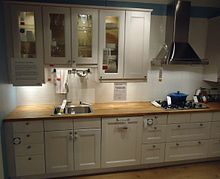 Uh-oh, it looks like some (many?) new or fairly new kitchen cabinets are outgassing several types of PCBs from the wood sealants used on the cabinets. PCBs (polychlorinated biphenyls) were banned in the 1970s due to health risks - for example, they are known carcinogens, and some are neurotoxic (also here).
Uh-oh, it looks like some (many?) new or fairly new kitchen cabinets are outgassing several types of PCBs from the wood sealants used on the cabinets. PCBs (polychlorinated biphenyls) were banned in the 1970s due to health risks - for example, they are known carcinogens, and some are neurotoxic (also here).
Researchers from the University of Iowa monitored air inside and outside 16 Iowa homes and found 3 types of PCBs (PCB-47, PCB-51, and PCB-68) wafting off the finished kitchen cabinets. They suggest that the PCBs becoming airborne are "unintentional impurities", that is, inadvertent byproducts of polymer sealants (from the common ingredient 2,4-dichlorobenzoyl peroxide) used in modern kitchen cabinetry. They found that unfinished cabinets had no PCB emissions. The concentrations seemed to be dependent on the year the house was built - with higher levels in houses built in the past 5 years (one house had just been completed), and also in a recently remodeled kitchen (new cabinets!). The cabinets were made by different manufacturers.
So now we have a new source of indoor air pollution to think about. The big questions are: 1) What, if anything, does this mean for human health? 2) How long does this outgassing from sealants go on for? 3) Are there alternative sealers that don't have this problem? By the way, the researchers discuss that household paints emit PCBs (such as PCB 11) as byproducts of paint pigment manufacturing, and yes, they were found both inside and outside houses. We love our plastics, use them in so many products, but there are consequences. From Env. Health News:
Finished kitchen cabinets are emitting toxic PCBs
Researchers tested indoor air at 16 homes and found three types of PCBs are widespread, and finished cabinets are the source of the toxics, according to a study released today. They suspect the PCBs [polychlorinated biphenyls] are byproducts of sealants used on the cabinets. The study, from the University of Iowa, is the first to suggest wood finishing products are a significant source of PCBs to indoor air and finds that, despite federal bans on PCBs, the chemicals are still being released into the environment, including our homes.
"The magnitude of these emissions is big," said Keri Hornbuckle, a professor of civil and environmental engineering at the University of Iowa and senior author of the new study, published in Environmental Science and Technology. "And no monitoring network inside our home would catch something like this."
PCBs were used in electrical equipment and as industrial solvents. The chemical family was banned in the 1970s amid concerns that PCBs accumulated in wildlife and people and were linked to reduced IQs, cancer and suppressed immune systems. Levels of the long-lasting compounds in the environment and our bodies have been steadily decreasing since the ban.
The amount of indoor emissions found in the current study is "similar to if you had an old light ballast in your house," Hornbuckle added, referring to a common source of PCBs from before they were banned.
Hornbuckle and colleagues found three types of PCBs— PCB-47, PCB-51, and PCB-68. They found more of the chemicals in newer and reconstructed homes. The homes tested were in and around Iowa City, Iowa.
"We know very little about these compounds, they've been under the radar. We don't know their potential developmental impacts, we don't know their half-lives," Laragy said. There is some nascent research—and it doesn't look good.: PCB-47 has been linked to liver problems; both PCB-47 and PCB-51 can disrupt hormones, and all three of the PCBs found in finished cabinetry "have neurotoxic potential," the authors wrote.
The cabinets tested were made by different companies, so it seems it's not a particular company at fault, rather the PCBs are byproducts of a process used by all cabinet makers. Unfinished cabinets tested had no PCBs on them.
It was already known that PCBs existed in polymer products, such as silicone and polyester, which are used to finish, seal and protect wood products like cabinets, however, researchers hadn't pinpointed the products as sources of PCBs to the environment. Part of the reason: testing is tricky—Hornbuckle and colleague used a very sensitive test that picks up many PCBs, a technique not many scientists or regulators use. PCB-47 can also be in the air due to legacy sources of PCBs, so the cabinets may have been missed as a source in the past.
Finished cabinets aren't the only ongoing source of PCBs—pigment manufacturing, especially yellow pigment, is also a major source, specifically for PCB-11. We reported last month that PCB-11 remains steady in Great Lakes air, while all legacy PCBs in the region are on a steady decline. In Hornbuckle's new study, PCB-11 was also found inside every home, and was often the most prevalent airborne PCB.
Under the Toxics Substances Control Act the U.S. Environmental Protection Agency allows some PCBs in manufacturing as "unintentional impurities." An EPA spokesperson said "this may be the first report that proposed a new source of the target PCB congeners in residential indoor air. However, we would need to further evaluate the results with respect to other potential sources of PCBs before making any more definitive statement."
